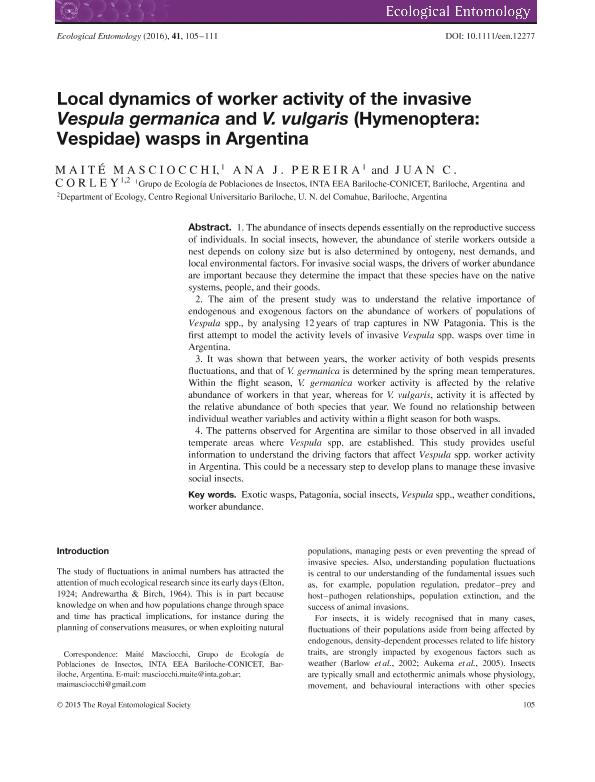Mostrar el registro sencillo del ítem
dc.contributor.author
Masciocchi, Maité

dc.contributor.author
Pereira, Ana Julia

dc.contributor.author
Corley, Juan Carlos

dc.date.available
2018-04-20T15:03:32Z
dc.date.issued
2015-11
dc.identifier.citation
Masciocchi, Maité; Pereira, Ana Julia; Corley, Juan Carlos; Local dynamics of worker activity of the invasive Vespula germanica and V. vulgaris (Hymenoptera: Vespidae) wasps in Argentina; Wiley Blackwell Publishing, Inc; Ecological Entomology; 41; 11-2015; 105-111
dc.identifier.issn
0307-6946
dc.identifier.uri
http://hdl.handle.net/11336/42823
dc.description.abstract
1. The abundance of insects depends essentially on the reproductive success of individuals. In social insects, however, the abundance of sterile workers outside a nest depends on colony size but is also determined by ontogeny, nest demands, and local environmental factors. For invasive social wasps, the drivers of worker abundance are important because they determine the impact that these species have on the native systems, people, and their goods.2. The aim of the present study was to understand the relative importance of endogenous and exogenous factors on the abundance of workers of populations of Vespula spp., by analysing 12 years of trap captures in NW Patagonia. This is the first attempt to model the activity levels of invasive Vespula spp. wasps over time in Argentina.3. It was shown that between years, the worker activity of both vespids presents fluctuations, and that of V. germanica is determined by the spring mean temperatures. Within the flight season, V. germanica worker activity is affected by the relative abundance of workers in that year, whereas for V. vulgaris, activity it is affected by the relative abundance of both species that year. We found no relationship between individual weather variables and activity within a flight season for both wasps.4. The patterns observed for Argentina are similar to those observed in all invaded temperate areas where Vespula spp. are established. This study provides useful information to understand the driving factors that affect Vespula spp. worker activity in Argentina. This could be a necessary step to develop plans to manage these invasive social insects.
dc.format
application/pdf
dc.language.iso
eng
dc.publisher
Wiley Blackwell Publishing, Inc

dc.rights
info:eu-repo/semantics/openAccess
dc.rights.uri
https://creativecommons.org/licenses/by-nc-sa/2.5/ar/
dc.subject
Exotic Wasps
dc.subject
Social Insects
dc.subject
Vespula Spp.
dc.subject
Weather Conditions
dc.subject.classification
Otras Ciencias Biológicas

dc.subject.classification
Ciencias Biológicas

dc.subject.classification
CIENCIAS NATURALES Y EXACTAS

dc.title
Local dynamics of worker activity of the invasive Vespula germanica and V. vulgaris (Hymenoptera: Vespidae) wasps in Argentina
dc.type
info:eu-repo/semantics/article
dc.type
info:ar-repo/semantics/artículo
dc.type
info:eu-repo/semantics/publishedVersion
dc.date.updated
2018-04-17T13:51:48Z
dc.journal.volume
41
dc.journal.pagination
105-111
dc.journal.pais
Reino Unido

dc.journal.ciudad
Londres
dc.description.fil
Fil: Masciocchi, Maité. Instituto Nacional de Tecnología Agropecuaria. Centro Regional Patagonia Norte. Estación Experimental Agropecuaria San Carlos de Bariloche. Laboratorio de Ecología de Insectos; Argentina
dc.description.fil
Fil: Pereira, Ana Julia. Instituto Nacional de Tecnología Agropecuaria. Centro Regional Patagonia Norte. Estación Experimental Agropecuaria San Carlos de Bariloche. Laboratorio de Ecología de Insectos; Argentina
dc.description.fil
Fil: Corley, Juan Carlos. Instituto Nacional de Tecnología Agropecuaria. Centro Regional Patagonia Norte. Estación Experimental Agropecuaria San Carlos de Bariloche. Laboratorio de Ecología de Insectos; Argentina
dc.journal.title
Ecological Entomology

dc.relation.alternativeid
info:eu-repo/semantics/altIdentifier/url/https://onlinelibrary.wiley.com/doi/abs/10.1111/een.12277
dc.relation.alternativeid
info:eu-repo/semantics/altIdentifier/doi/http://dx.doi.org/10.1111/een.12277
Archivos asociados
